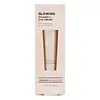What's inside
What's inside
 Key Ingredients
Key Ingredients

 Benefits
Benefits

 Concerns
Concerns

 Ingredients Side-by-side
Ingredients Side-by-side

Water
Skin ConditioningGlycerin
HumectantRosa Rugosa Flower Water
MaskingGlycereth-26
HumectantPolysorbate 60
EmulsifyingNiacinamide
SmoothingCetearyl Alcohol
EmollientPropylene Glycol
HumectantAcrylates/C10-30 Alkyl Acrylate Crosspolymer
Emulsion StabilisingTocopheryl Acetate
AntioxidantHydrogenated Palm Kernel Oil
EmollientArginine
MaskingChlorphenesin
AntimicrobialCitric Acid
BufferingGlycolic Acid
BufferingCetearyl Glucoside
EmulsifyingAllantoin
Skin ConditioningLactic Acid
BufferingAscorbic Acid
AntioxidantCaprylic/Capric Glycerides
EmollientCaprylhydroxamic Acid
1,2-Hexanediol
Skin ConditioningEthylhexylglycerin
Skin ConditioningDisodium EDTA
Phospholipids
Skin ConditioningPEG-20
HumectantGlucose
HumectantPhenoxyethanol
PreservativeWater, Glycerin, Rosa Rugosa Flower Water, Glycereth-26, Polysorbate 60, Niacinamide, Cetearyl Alcohol, Propylene Glycol, Acrylates/C10-30 Alkyl Acrylate Crosspolymer, Tocopheryl Acetate, Hydrogenated Palm Kernel Oil, Arginine, Chlorphenesin, Citric Acid, Glycolic Acid, Cetearyl Glucoside, Allantoin, Lactic Acid, Ascorbic Acid, Caprylic/Capric Glycerides, Caprylhydroxamic Acid, 1,2-Hexanediol, Ethylhexylglycerin, Disodium EDTA, Phospholipids, PEG-20, Glucose, Phenoxyethanol
Cyclopentasiloxane
EmollientWater
Skin ConditioningIsostearyl Palmitate
EmollientPolyethylene
AbrasiveButylene Glycol
HumectantPolysilicone-11
Ethylene/Acrylic Acid Copolymer
Emulsion StabilisingMorus Bombycis Root Extract
Skin ConditioningCaffeine
Skin ConditioningPhytosphingosine
Skin ConditioningTriticum Vulgare Bran Extract
Skin ConditioningScutellaria Baicalensis Root Extract
AstringentLactis Proteinum
Skin ConditioningOlea Europaea Fruit Extract
BleachingCamellia Sinensis Leaf Extract
AntimicrobialCholesterol
EmollientLinoleic Acid
CleansingTocopheryl Acetate
AntioxidantMagnesium Ascorbyl Phosphate
AntioxidantPyridoxine Dipalmitate
Skin ConditioningSucrose
HumectantGlycerin
HumectantDimethicone
EmollientGlyceryl Laurate
EmollientPEG/PPG-18/18 Dimethicone
EmulsifyingPetrolatum
EmollientCetyl PEG/PPG-10/1 Dimethicone
EmulsifyingPropylene Carbonate
SolventSodium Chloride
MaskingQuaternium-90 Bentonite
Disodium EDTA
Phenoxyethanol
PreservativeIron Oxides
Cyclopentasiloxane, Water, Isostearyl Palmitate, Polyethylene, Butylene Glycol, Polysilicone-11, Ethylene/Acrylic Acid Copolymer, Morus Bombycis Root Extract, Caffeine, Phytosphingosine, Triticum Vulgare Bran Extract, Scutellaria Baicalensis Root Extract, Lactis Proteinum, Olea Europaea Fruit Extract, Camellia Sinensis Leaf Extract, Cholesterol, Linoleic Acid, Tocopheryl Acetate, Magnesium Ascorbyl Phosphate, Pyridoxine Dipalmitate, Sucrose, Glycerin, Dimethicone, Glyceryl Laurate, PEG/PPG-18/18 Dimethicone, Petrolatum, Cetyl PEG/PPG-10/1 Dimethicone, Propylene Carbonate, Sodium Chloride, Quaternium-90 Bentonite, Disodium EDTA, Phenoxyethanol, Iron Oxides
 Reviews
Reviews

Ingredients Explained
These ingredients are found in both products.
Ingredients higher up in an ingredient list are typically present in a larger amount.
Disodium EDTA plays a role in making products more stable by aiding other preservatives.
It is a chelating agent, meaning it neutralizes metal ions that may be found in a product.
Disodium EDTA is a salt of edetic acid and is found to be safe in cosmetic ingredients.
Learn more about Disodium EDTAGlycerin is already naturally found in your skin. It helps moisturize and protect your skin.
A study from 2016 found glycerin to be more effective as a humectant than AHAs and hyaluronic acid.
As a humectant, it helps the skin stay hydrated by pulling moisture to your skin. The low molecular weight of glycerin allows it to pull moisture into the deeper layers of your skin.
Hydrated skin improves your skin barrier; Your skin barrier helps protect against irritants and bacteria.
Glycerin has also been found to have antimicrobial and antiviral properties. Due to these properties, glycerin is often used in wound and burn treatments.
In cosmetics, glycerin is usually derived from plants such as soybean or palm. However, it can also be sourced from animals, such as tallow or animal fat.
This ingredient is organic, colorless, odorless, and non-toxic.
Glycerin is the name for this ingredient in American English. British English uses Glycerol/Glycerine.
Learn more about GlycerinPhenoxyethanol is a preservative that has germicide, antimicrobial, and aromatic properties. Studies show that phenoxyethanol can prevent microbial growth. By itself, it has a scent that is similar to that of a rose.
It's often used in formulations along with Caprylyl Glycol to preserve the shelf life of products.
Tocopheryl Acetate is AKA Vitamin E. It is an antioxidant and protects your skin from free radicals. Free radicals damage the skin by breaking down collagen.
One study found using Tocopheryl Acetate with Vitamin C decreased the number of sunburned cells.
Tocopheryl Acetate is commonly found in both skincare and dietary supplements.
Learn more about Tocopheryl AcetateWater. It's the most common cosmetic ingredient of all. You'll usually see it at the top of ingredient lists, meaning that it makes up the largest part of the product.
So why is it so popular? Water most often acts as a solvent - this means that it helps dissolve other ingredients into the formulation.
You'll also recognize water as that liquid we all need to stay alive. If you see this, drink a glass of water. Stay hydrated!
Learn more about Water